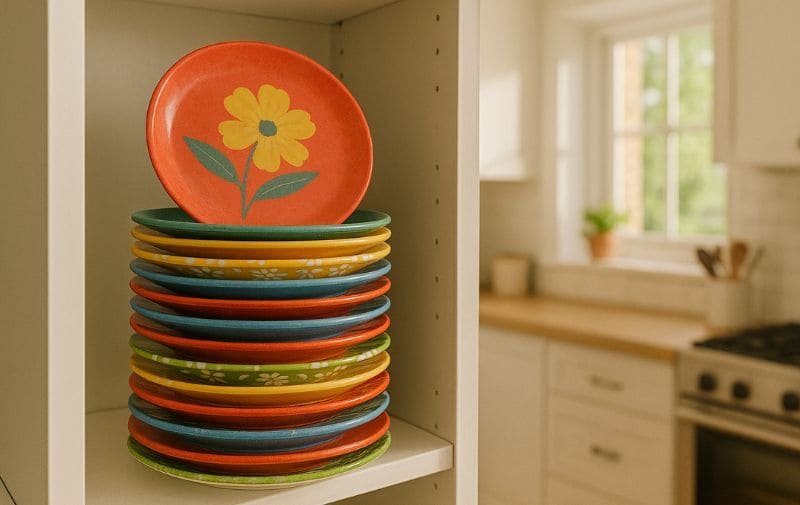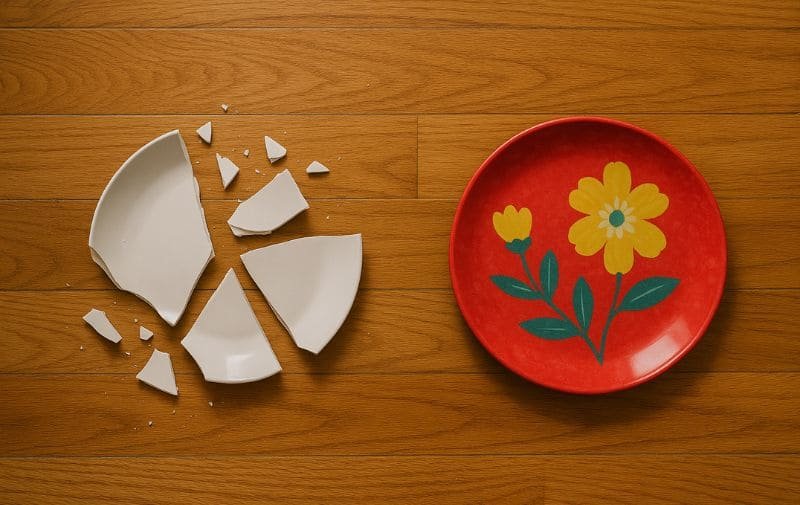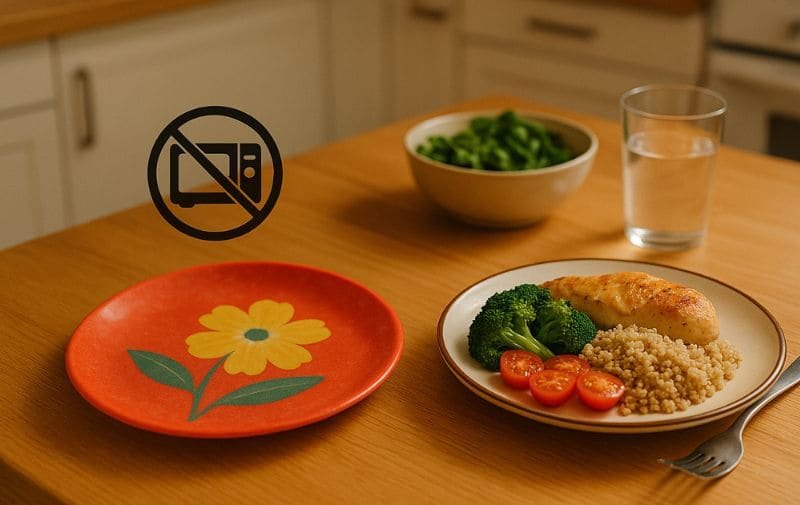Tired of shattered ceramic? Looking for stylish yet durable dinnerware? Melamine plates often come up, but with so much information (and misinformation), it’s hard to know if they’re a truly good choice.
High-quality A5 melamine plates are a durable, lightweight, and stylish dinnerware option, generally safe for serving food (even hot!). However, they are absolutely NOT microwave-safe, and understanding the material grade (A5 vs. A1) is critical for ensuring safety and performance.
Last Updated: 10th. June 2025 | Estimated Reading Time: 9 Minutes
What Exactly ARE Melamine Plates (And Why Grade Matters)?
You hear “melamine,” and “plastic” might spring to mind. But it’s not just any plastic. The type and grade are super important for safety and quality.
Melamine plates are made from melamine-formaldehyde resin, an organic-based compound. Crucially, food-grade A5 melamine is designed for tableware, while A1 melamine is not and should be avoided for food. Bamboo fiber plates often use A5 melamine as a binder.

The All-Important Material Grade: A5 vs. A1
- A5 Melamine: This is the food-grade standard you should always insist on for dinnerware. It’s pure, properly cured melamine-formaldehyde resin designed for safe, repeated contact with food. High-quality A5 melamine is BPA-free (as melamine itself doesn’t contain BPA) and complies with food safety standards like FDA and LFGB.
- Bamboo Fiber Plates: Often, these popular “eco-look” plates use A5 melamine resin as a binder for bamboo powder. They share the core durability and safety benefits of pure A5 melamine, with a different aesthetic and texture.
- Bamboo Fiber Plates: Often, these popular “eco-look” plates use A5 melamine resin as a binder for bamboo powder. They share the core durability and safety benefits of pure A5 melamine, with a different aesthetic and texture.
- A1 Melamine (Urea-Formaldehyde): AVOID A1 melamine for any food contact. A1 contains urea and has significantly lower heat resistance. It’s not designed or safe for repeated use with food, especially warm or acidic items, as it can leach harmful chemicals. A1 is typically used for non-food applications like electrical fittings.
Feature A5 Melamine (Food Grade) 🍽️ A1 Melamine (Industrial Grade) ⚠️ Primary Use Dinnerware, food containers Electrical fittings, non-food items Composition Melamine-formaldehyde resin Often Urea-formaldehyde based Food Safety Safe for food contact NOT safe for food contact Heat Resistance Good for serving hot food Lower, can degrade with heat Durability High Lower Cost Generally higher Generally lower Recommendation Choose this for tableware AVOID for tableware Industry Insider Tip: Always check for A5 grading or explicit food-safe certifications (like NSF, FDA, or LFGB compliance) when buying melamine dinnerware. If the grade isn’t specified, be cautious, especially with very cheap options.
The Bright Side: Why Choose Melamine Plates?
So, why do so many people choose melamine plates, from busy restaurants to families? There are some pretty compelling benefits that make them a popular pick.
Key advantages of melamine plates include exceptional durability and break-resistance, being lightweight and easy to handle. They also offer great design versatility, are often cost-effective compared to ceramic, and are typically dishwasher safe for easy cleanup.
Benefit #1: Exceptional Durability and Break-Resistance 💪
This is melamine’s superpower. Unlike ceramic or glass, melamine plates are highly resistant to chipping, cracking, and shattering when dropped. This makes them ideal for:
- Families with young children
- Outdoor dining, picnics, and camping
- Restaurants, schools, and high-traffic canteens
Benefit #2: Lightweight and Easy to Handle 🍃
Compared to stoneware, porcelain, or even stainless steel, melamine plates are significantly lighter. This makes a big difference when you’re carrying a stack of plates, or for kids who are learning to set the table or carry their own plate.
- Commercial staff carrying large stacks.
- Elderly individuals or those with limited strength.
- Packing for travel or outdoor events.

Benefit #3: Design Versatility and Aesthetic Appeal 🎨
Melamine can be produced in a stunning array of colors, patterns, and unique shapes. Designs are often decals fused into the material during molding, meaning they won’t peel or wear off easily. This allows for vibrant, intricate aesthetics that are harder to achieve or more expensive in ceramic.
Benefit #4: Generally More Cost-Effective Than Ceramic 💰
While high-quality A5 melamine or bamboo fiber isn’t the cheapest “plastic” option, it’s often more budget-friendly than ceramic or porcelain, especially when considering its lifespan and low replacement rate due to breakage.
Benefit #5: Typically Dishwasher Safe for Easy Cleaning 🧼
Most A5 melamine and A5-bonded bamboo fiber plates are designed to be top-rack dishwasher safe, simplifying cleanup. This is a vital feature for both busy households and commercial food service.
| Advantage Category | Specific Benefit for You | |
|---|---|---|
| Durability | Reduces replacement costs; safer for kids. | 💪 |
| Weight | Easier to carry, stack, and handle. | 🍃 |
| Design | Wide choice of colors, patterns, and modern shapes. | 🎨 |
| Cost | Good long-term value due to longevity. | 💰 |
| Maintenance | Easy to clean, usually dishwasher safe. | 🧼 |
The Critical Caveats: What Are the Disadvantages of Melamine Plates?
No product is perfect, and melamine plates have some important downsides. Knowing these limitations is key to using them safely and keeping them in good shape.
The main disadvantages of melamine plates are that they are NOT microwave safe. They can also potentially stain or scratch over time with certain foods or sharp utensils, and their end-of-life disposal raises environmental questions..
Disadvantage #1: Not Microwave Safe – The Unbreakable Rule 🚫♨️
This is the most critical limitation. Putting melamine plates in the microwave can cause the resin to absorb energy, leading to:
- The plate becoming extremely hot, posing a burn risk.
- Potential breakdown of the resin over time, possibly leading to chemical leaching.
- Warping, cracking, or other damage to the plate’s integrity. Simply put: Never microwave melamine dinnerware.

Disadvantage #2: Understanding Temperature Limits (Can You Put Hot Food On Them?)
While not for microwave use, yes, you can safely put hot served food on A5 melamine plates. They are designed to handle typical food serving temperatures (generally up to 70°C / 160°F continuously, with short-term tolerance for hotter freshly cooked food). The key is they are for serving hot food, not cooking or reheating food on. They are also not oven-safe.
Disadvantage #3: Potential for Staining and Scratching Over Time
- Staining: While good quality A5 melamine resists stains well, prolonged contact with highly pigmented foods (tomato sauce, curry, berries, turmeric) can eventually lead to faint staining, especially on lighter colors if not washed promptly.
- Scratching: Aggressive use of sharp, serrated knives can cause superficial scratches. Melamine is more scratch-resistant than cheap plastics but not as hard as glazed ceramic.
Disadvantage #4: End-of-Life Disposal and Environmental Considerations ♻️❓
Melamine is a thermosetting plastic, which makes it difficult and not widely recycled. Its primary eco-benefit comes from its durability (leading to less waste from broken dishes) and, in the case of bamboo fiber melamine, the use of a renewable resource (bamboo) as a filler. It’s not biodegradable.
Disadvantage #5: Wear and Tear – Expected Lifespan
With proper care, high-quality A5 melamine plates can last for many years. However, after extensive use (especially in commercial settings), they may eventually show signs of wear like loss of gloss, increased susceptibility to staining, or fine scratches. Their lifespan is excellent but not infinite.
Hot Topic: Can You Really Put Hot Food on Melamine Plates Safely?
Let’s clear this up definitively. Yes, you can serve freshly cooked, hot food (like pasta, steamed vegetables, or grilled chicken) directly onto high-quality A5 melamine plates without safety concerns. They are designed to withstand normal serving temperatures (typically up to 70°C/160°F) without leaching harmful substances or damaging the plate. Just don’t cook on them.
The plate itself will not get excessively hot from the food alone (though the food, of course, will be hot). The danger lies with external heat sources like microwaves or ovens, which can superheat the melamine material itself.
Here’s a quick summary of what to do and what to avoid:
| Melamine Plate Usage | Safe? ✅/❌ | Why? |
|---|---|---|
| Serving Hot Food | ✅ | Designed for typical serving temperatures (e.g., up to 70°C/160°F) |
| Cold Food / Salads | ✅ | Perfectly safe |
| Dishwasher (Top Rack) | ✅ | Most A5 melamine is dishwasher safe for easy cleaning |
| Microwave Oven | ❌ | Can damage plate, cause superheating, potential leaching |
| Conventional Oven | ❌ | Will melt or damage the plate |
| Cutting with Sharp Knives | 🆗 (with care) | Can cause superficial scratches over time |
Quick Tip: If a food is too hot to comfortably eat, it’s perfectly fine to serve on an A5 melamine plate.
Melamine Plates vs. The Competition: A Head-to-Head Showdown
Choosing dinnerware means weighing options. How do melamine plates really stack up against old favorites like ceramic, other plastics, or even trendy stainless steel?
Melamine plates offer superior durability and lighter weight than ceramic, and better quality than generic plastics. Stainless steel is more robust but lacks design options. Bamboo fiber plates share melamine’s A5 binder benefits with a different aesthetic.
When I was deciding on new plates, I did a lot of comparing. Here’s how I see melamine fitting in:
Melamine vs. Ceramic (like porcelain or stoneware): Melamine wins big on durability and being lightweight. No more heartbreak over shattered heirlooms! Ceramic can go in the microwave and oven, which melamine can’t, and some prefer its classic, heavier feel. Scratches are less of an issue with glazed ceramic.
Melamine vs. Other Plastic Plates (like polypropylene or SAN): A5 melamine is much more rigid, has better heat resistance (won’t warp as easily with hot food), is significantly more scratch-resistant, and generally has a more premium look and feel. Generic plastics might be cheaper upfront and some are microwaveable, but they often don’t last as long or feel as nice.
Melamine vs. Stainless Steel Plates: Stainless steel is virtually indestructible and very hygienic, and some types can even go in an oven. However, it can get very hot to the touch with hot food, can be noisy (clanking!), and you’re pretty much stuck with a metallic look – no fun colors or patterns like with melamine.
A5 Melamine Plates vs. Bamboo Fiber Plates: This is an interesting one because most “bamboo fiber plates” actually use A5 melamine resin as a binder for the bamboo powder. So, they share many of the same pros and cons: durable, lightweight, not microwaveable, but dishwasher safe. The main difference is the aesthetic – bamboo fiber often has a more natural, matte finish and an eco-friendlier vibe due to the bamboo content. The feel can also be slightly different.
How does melamine stack up against other common plate materials?
| Feature | A5 Melamine Plates | Ceramic (Porcelain/Stoneware) | Other Plastic (PP, SAN) | Stainless Steel |
|---|---|---|---|---|
| Break Resistance | ⭐ Excellent | ⚠️ Poor to Fair | ✅ Good to Excellent | ⭐ Excellent |
| Weight | ✅ Lightweight | ⚠️ Heavy | ✅ Very Lightweight | Fairly Lightweight |
| Microwave Safe | 🚫 NO | ✅ Yes | Varies (Often Yes) | Some Types Yes |
| Oven Safe | 🚫 NO | ✅ Yes | 🚫 No | ✅ Yes |
| Design Options | ⭐ Excellent (Colors/Prints) | ✅ Good (Classic, Glazes) | Fair (Often Basic) | Limited (Utilitarian) |
| Scratch Resistance | Fair to Good | ⭐ Excellent | ⚠️ Poor to Fair | Good |
| Hot Food Serving | ✅ Yes | ✅ Yes | ✅ Yes | ✅ Yes |
| Typical Cost | Moderate | Moderate to High | Low to Moderate | Moderate |
Key Takeaways from the Comparison:
- Choose A5 Melamine if: Durability, lightweight design, vibrant patterns, and kid-friendliness are top priorities, and you never use a microwave for plates.
- Consider Ceramic if: Microwave/oven use is essential, and you prefer a classic, heavier feel and maximum scratch resistance.
- Opt for other Plastics (food-grade) if: Budget is the absolute primary concern, and some microwave use is needed (check specific plastic type).
- Stainless Steel is best for: Extreme durability, hygiene (industrial settings), and if oven/microwave use is needed with a non-breakable material.

Keeping Them Pristine: Pro Care Tips for Your Melamine Dinnerware
You’ve got your melamine plates, and you love them! Now, how do you make sure they stay looking good and last as long as possible? Proper care is simple.
- DO: Wash promptly after use, especially with stain-prone foods.
- DO: Use a soft cloth or sponge for cleaning. Most are top-rack dishwasher safe.
- DO: Check for “dishwasher safe” labels.
- DON’T: Use serrated knives aggressively on the surface.
- DON’T: Use abrasive cleaners, steel wool, or scouring pads.
- DON’T EVER: Put them in the microwave or oven.
- DON’T: Expose to direct stovetop heat.
Stain Removal Tip: For stubborn faint stains, try making a paste of baking soda and water, apply it to the stain, let it sit for 15-20 minutes, then gently rub and rinse.
A Buyer’s Guide: Are Melamine Plates the Smart Choice for You?
Deciding if melamine plates are right for your needs involves weighing their pros and cons against your specific situation.
Melamine plates are an excellent choice for:
- Families with young children: Due to their break-resistance and fun designs.
- Outdoor enthusiasts: For picnics, BBQs, camping, and RV use thanks to their light weight and durability.
- Boating and poolside dining: Where broken glass is a safety hazard.
- Casual dining restaurants, cafes, and canteens: Seeking durable, stylish, and cost-effective tableware.
- Anyone prioritizing shatter-resistance over microwave compatibility.
Melamine plates might NOT be the best choice if:
- You frequently reheat food directly on plates in a microwave.
- You prefer the heft and classic feel of ceramic for all your dining.
- You are looking for biodegradable or easily recyclable options.
Ultimately, if you understand and respect their primary limitation (no microwave use), high-quality A5 melamine plates offer a fantastic combination of practicality, style, and safety for many households and food service applications.
Frequently Asked Questions
Question 1: Is A5 melamine truly safe for daily food contact?
Yes, A5 grade and bamboo fiber melamine when manufactured by reputable companies and certified by bodies like FDA or LFGB, is considered safe for daily food contact. It does not leach harmful amounts of chemicals into food when used as intended (i.e., not microwaved).
Question 2: Can melamine plates handle very cold foods, like ice cream?
Absolutely. Melamine is stable at cold temperatures and is perfectly fine for serving frozen desserts or very cold salads.
Question 3: What’s the difference in feel between A5 melamine and bamboo fiber plates?
Pure A5 melamine plates often have a smoother, glossier finish. Bamboo fiber plates (which use A5 melamine as a binder) typically have a more matte, slightly textured finish, giving them a more natural or earthy feel. Both are durable and food-safe.
Question 4: How can I tell if a melamine plate is A5 grade if it’s not labeled?
It can be difficult without explicit labeling or manufacturer information. Reputable brands usually state the grade or food-safe certifications. If in doubt, especially with unbranded or extremely cheap items, it’s safer to assume it might not be A5. Always prioritize products with clear safety and material information.
Summary and Recommendations
Melamine plates, particularly those made from certified A5 food-grade melamine or A5-bonded bamboo fiber, offer an impressive suite of benefits: they are exceptionally durable, break-resistant, lightweight, and come in a vast array of designs. They are a safe option for serving all types of food, including hot meals.
The golden rule is their biggest con: melamine plates are not microwave safe. Understanding this, along with their potential for scratching with very aggressive knife use and the fact they aren’t easily recycled, allows you to make an informed decision. For many, the pros of melamine plates far outweigh the cons, providing a reliable, stylish, and long-lasting dinnerware solution.
Recommended Internal & External Links:
- Explore Duramela Certified A5 Melamine Dinnerware Collections
- Understanding Food Grade Plastics: FDA Guidelines
- Wikipedia – Melamine Resin



